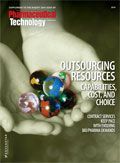A Silver Milestone for Drug Development
Pharmaceutical Technology Europe Marks 25 years of drug-development advances.
This month, Pharmaceutical Technology’s sister publication, Pharmaceutical Technology Europe, marks its 25th anniversary of publishing technical papers, articles, news, and product information about drug- development processes in Europe.
Anniversaries are the time to mark progress and project future potential. In a special issue, the editors of Pharmaceutical Technology Europe and experts from sectors of the bio/pharmaceutical industry share perspectives on technologies and trends that were key influencers in the development of drug therapies over the past 25 years. While I share some of the highlights here, complete content can be found here.
Business and regulatory changes
In “No Signs of a Slowdown in Mergers,” Faiz Kermani reflects on shifts in drug company ownership in the past three decades. In 1985, the top 10 pharmaceutical companies accounted for approximately 20% of worldwide sales. In 2012, the top 10 companies captured 42% of global sales, he writes. Reasons for mergers included improving R&D productivity and increasing revenues to compensate for lost sales of drugs losing patent protection. Another incentive for acquisitions is to expand to emerging markets, which are growing at a faster annual rate than Europe, the United States, and Japan.
The use of contract service providers also expanded over the past 25 years, says Eric Langer, president and managing partner of BioPlan Associates. Borders and location have become less important, relative to a supplier’s technical, client service, and quality competence. In 1989, there were only a few biopharmaceutical CMOs and few biopharma companies that outsourced tasks. Instead, some companies purchased up- and downstream subsidiaries to ensure they were vertically integrated. This strategy did not work for many companies and outsourcing, especially in bioprocessing, became more common in the early 2000s.
Sean Milmo tracks the evolution of regulatory oversight and enforcement in Europe, from legislative activity in the 1950s to introduce stricter regulations following the discovery that thalidomide caused birth defects, to the establishment of the European Medicines Agency. The European Regulatory Watch column can be found on pages 16-17 of this issue.
Drug formulations evolve
Experts also provided predictions of technology approaches in key areas.
Quality by design, continuous manufacturing, tooling, film coating, and polymers for solubility were identified as key contributions to the advancement of solid-dosage development.
Softgel technology, which originated in the 1930s, has moved from consumer products to acceptance as an alternative drug-delivery vehicle for lead candidates that are difficult to formulate.
Biosimilar drugs have gained approval in Europe, including monoclonal antibody products. While development costs, naming issues, and payer resistance present some challenges, the future looks promising.
Technologies drive development
Single-use technologies have moved from small-volume storage to standard practice in key areas of biopharmaceutical production. Experts say, however, that further advances are needed to resolve some operational limitations.
Safety and security threats have resulted in drug packaging changes, industry experts report. For example, advances in needle shielding have helped reduce needle sticks by medical personnel, Currently, serialization is a challenge for the pharmaceutical industry, as manufacturers implement regulatory requirements for different regions.
Supply chain issues are a global concern. Representatives of the European Fine Chemicals Group of the European Chemical Industry Council, IPEC Europe and EXCiPACT discuss programs to ensure the safety of APIs and excipients and how global harmonization can help improve supply-chain security and reduce the flow of falsified and sub-standard medicine into Europe.

Drug Solutions Podcast: A Closer Look at mRNA in Oncology and Vaccines
April 30th 2024In this episode fo the Drug Solutions Podcast, etherna’s vice-president of Technology and Innovation, Stefaan De Koker, discusses the merits and challenges of using mRNA as the foundation for therapeutics in oncology as well as for vaccines.
WMFTS’ BioPure to Showcase Single-Use Bioclamp with Refined Manufacturing at INTERPHEX 2025
April 1st 2025With advanced manufacturing, BioPure’s BioClamp connector is manufactured to be 13% lighter than the previous model, resulting in a 26% reduction in carbon dioxide emissions across the full lifecycle of the product.
Drug Solutions Podcast: Gliding Through the Ins and Outs of the Pharma Supply Chain
November 14th 2023In this episode of the Drug Solutions podcast, Jill Murphy, former editor, speaks with Bourji Mourad, partnership director at ThermoSafe, about the supply chain in the pharmaceutical industry, specifically related to packaging, pharma air freight, and the pressure on suppliers with post-COVID-19 changes on delivery.